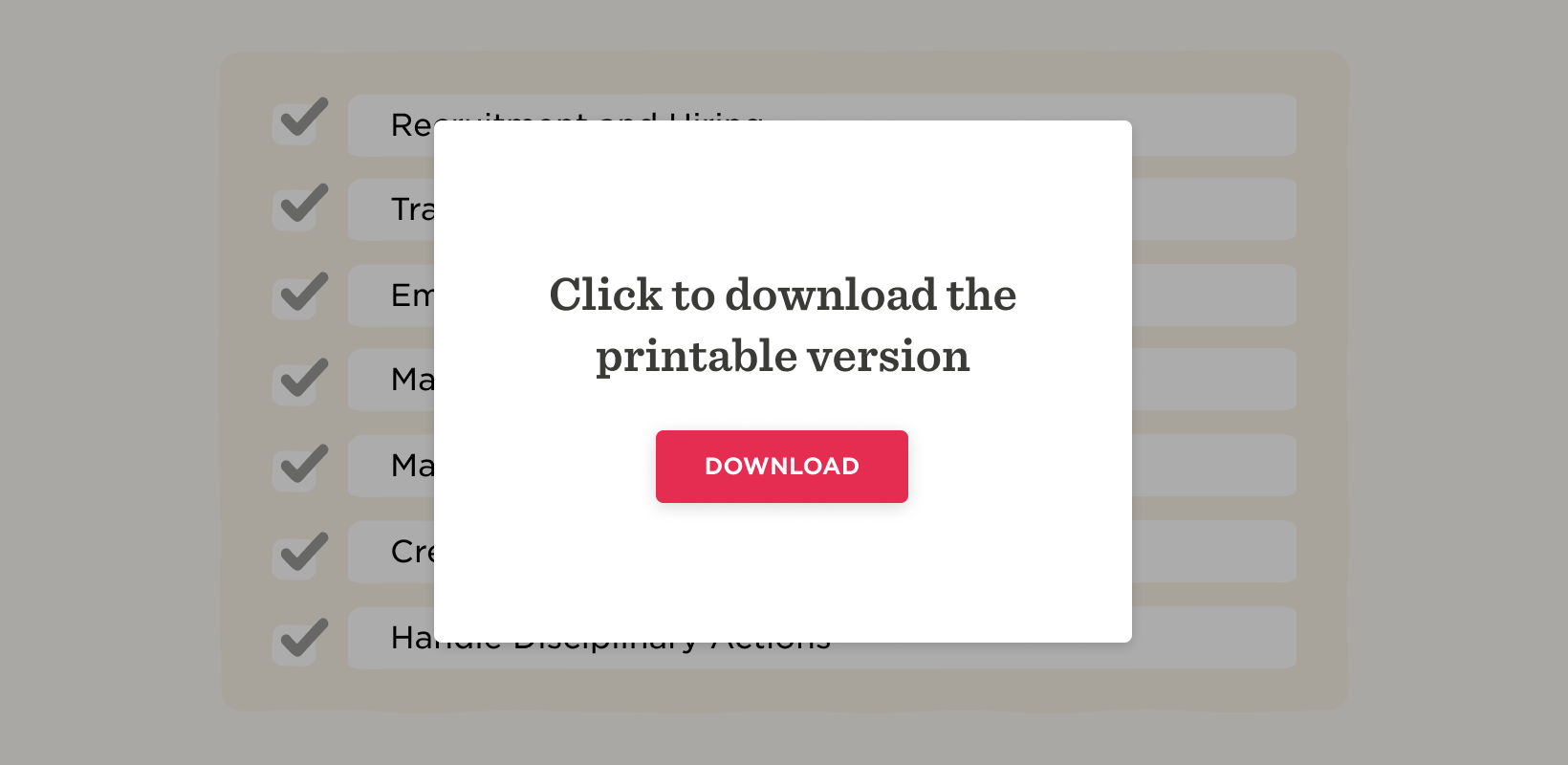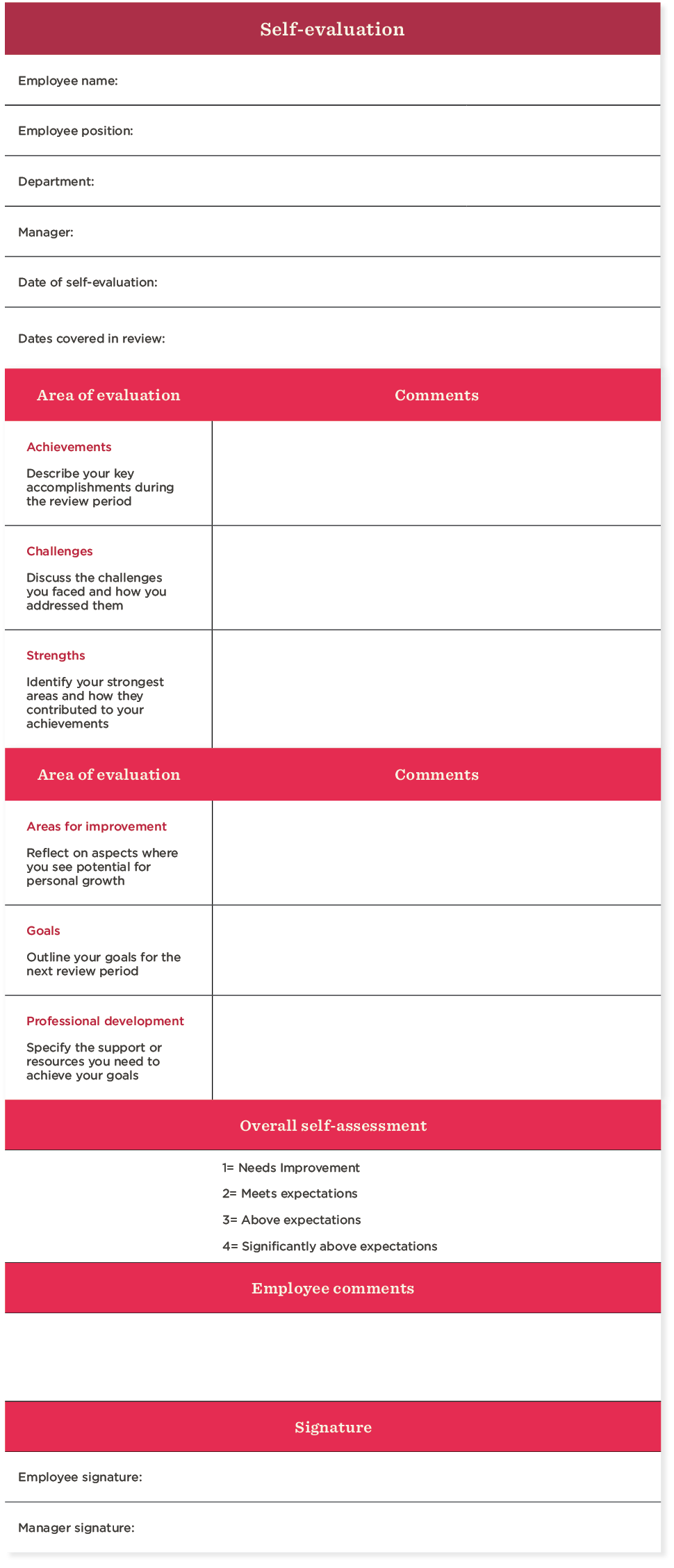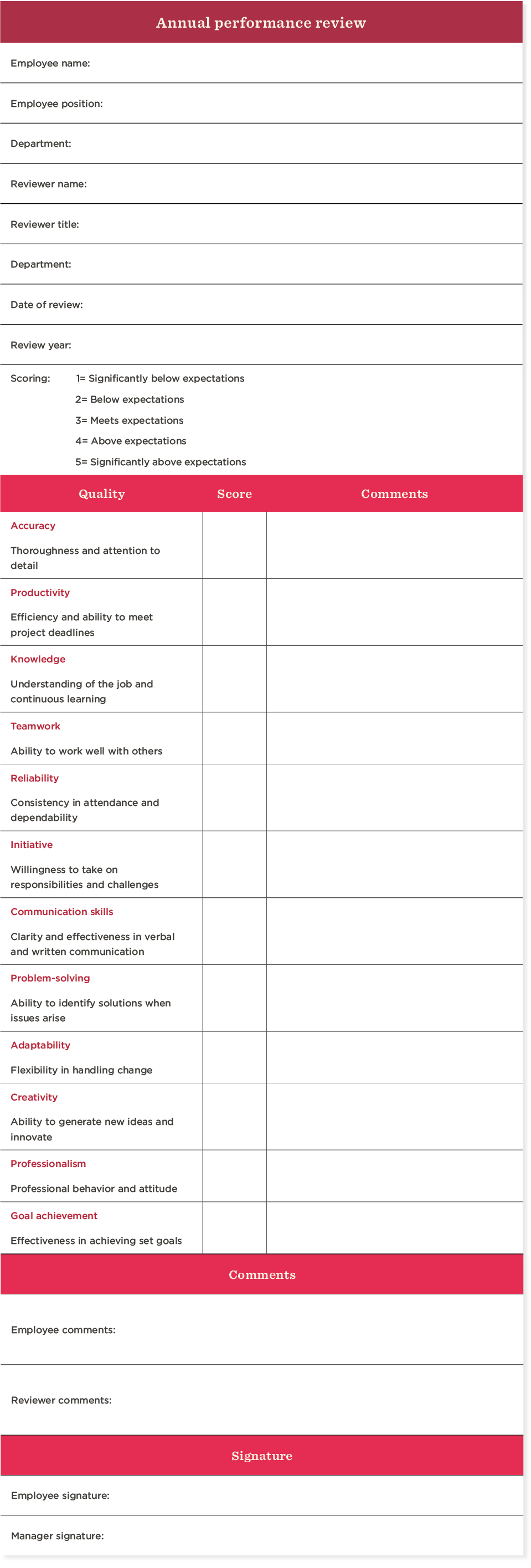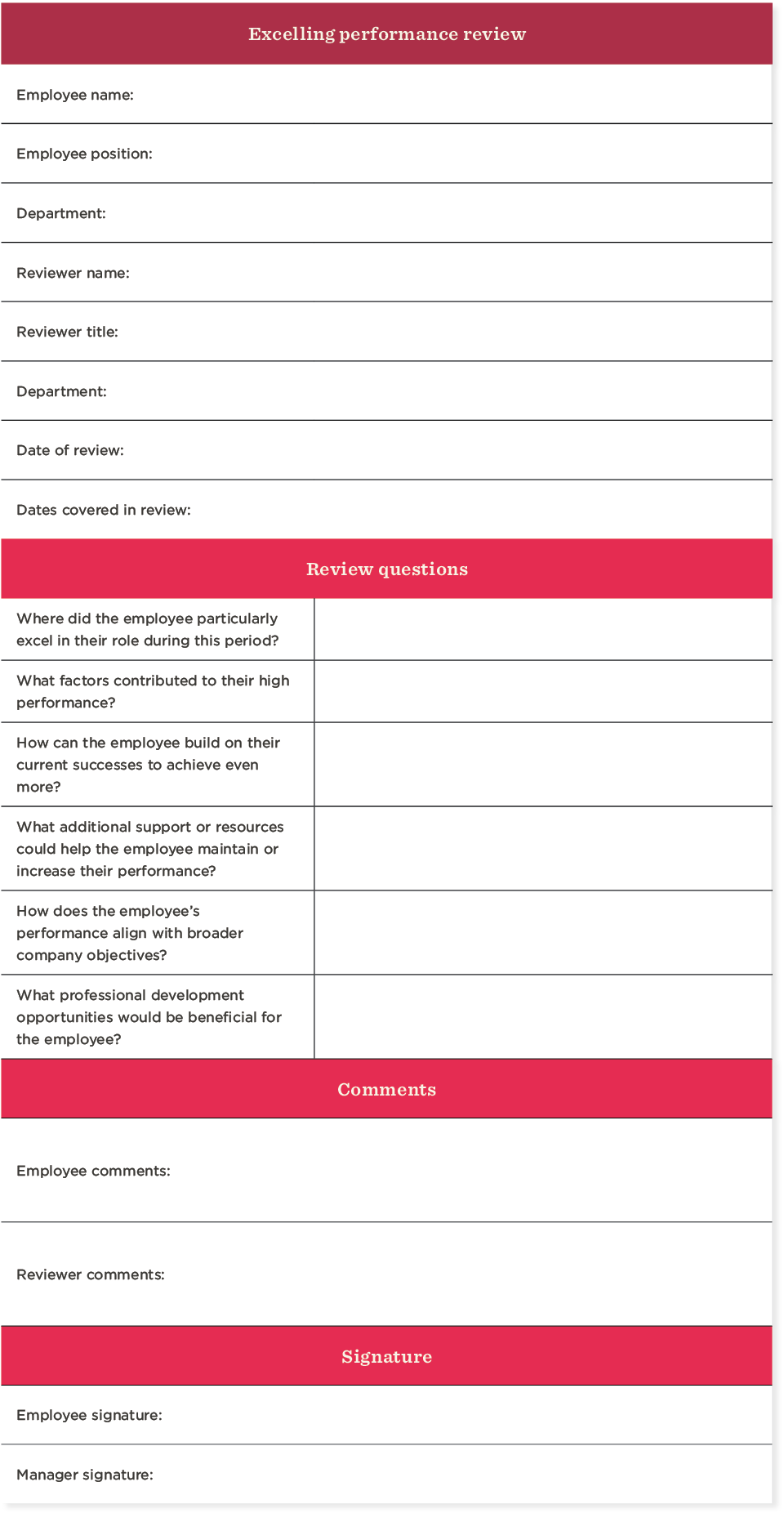Historically, end-of-year performance reviews or appraisals were the standard practice for evaluating performance. However, this model often limited feedback to past behaviors and didn’t focus on improving performance or developing skills for future success.
Modern companies recognized these limitations and shifted performance management toward frequent conversations about performance and development between employees, managers, and other stakeholders.
This new model—simplified by structured performance management review templates—creates opportunities for communication and support without waiting until the end of the year. The results? Higher employee satisfaction and retention levels.

This performance management review guide will:
- Explain the meaning of performance management
- Walk through the stages of the performance management process
- Explore different performance management frameworks and approaches
- Provide free performance management templates
- Dive into performance management approaches
<<Start your performance management process with these free templates.>>
What is performance management?
Organizations use performance management to monitor, measure, and improve the performance of individuals, departments, and the organization as a whole.
HR leaders can implement performance management strategies to help team members improve productivity, develop new skills, and take an active part in promoting organizational goals.
Traditionally, organizations reduced performance management to annual reviews focused only on measurable outcomes. But, this model can be ineffective and even harmful to performance.
How does an organization monitor and improve performance without generating stress, anxiety, and inefficiency? Clarity, consistency, and kindness.
Clarity
Clarity refers to setting goals and expectations that meet the SMART criteria. Developed by a professor of organizational psychology in the 1980s, this acronym describes goals that are Specific, Measurable, Achievable, Relevant, and Timely.
Organizations can clarify their overall values and vision before setting expectations. When leaders communicate goals clearly, everyone can experience less confusion and greater unity.
Consistency
Consistency entails providing continual feedback at predetermined intervals and according to a specific methodology and protocol. This allows you to identify and address necessary challenges quickly and kindly and avoid blindsiding people at annual reviews.
Kindness
Kindness is a foundational aspect of company culture. Rating people’s performance won’t boost a company’s success; HR leaders can pair reviews with training and skill improvement initiatives to encourage employee development and drive overall growth.
Focus on constructive feedback and expressing appreciation for the person’s efforts and achievements. Approach conversations with empathy and provide supportive feedback that helps the individual grow.
With clarity, consistency, and kindness, you can build a performance management review process that promotes work quality, adherence to company values, and growth.
Performance management vs. performance appraisal vs. management by objectives
The terms performance management, performance appraisal, and management by objectives are similar, but each plays a different role within HR.
Performance management helps improve team member performance and align it with organizational goals. It involves setting expectations, gathering ongoing feedback, and embracing continuous development.
Performance appraisals are regular evaluations that focus on past achievements and identify areas for improvement. Often administered quarterly, they discuss accomplishments, challenges, and possible areas of improvement based on previous check-ins. They serve as feedback mechanisms within the performance management process.
Management by objective (MBO) refers to when managers and team members set specific, measurable goals together, and managers then assess performance against these objectives. This method emphasizes structured goal-setting and regular progress reviews.
Together, these elements create a dynamic and integrated approach to driving team member success and organizational growth. By effectively integrating these three strategies, HR teams can create a comprehensive system that supports continuous development, provides meaningful feedback, and aligns individual goals with the company’s broader mission.
How does performance management work?
Performance management consists of three stages: planning, check-in, and review. Think of these three steps as the magic key to supporting your people and achieving better results.
1. Planning
Planning involves setting individual goals in the context of departmental and organizational goals. Clarify these goals with each person to ensure everyone understands and agrees on their targets and deliverables.
2. Check-in
Set times for periodic reviews or check-ins to address pain points and keep project management functioning and consistent. Create ample opportunities for employees and managers to revisit goals and adjust as needed.
3. The review
Regular check-ins culminate in a review, or performance appraisal, where an employee’s job performance and overall contribution to the company are evaluated according to set criteria. These meetings focus on employee development and how management and teams can work together to achieve organizational goals.
What are performance management templates?
Teams can use performance management review templates to streamline evaluation and feedback within organizations. Templates provide a standardized approach to assessing performance, setting goals, and planning development strategies. They help maintain consistency and fairness across team member evaluations.
<<Create fair and consistent performance reviews with these performance management templates.>>
What to include in performance management templates
Effective performance management focuses on improving skills and motivation—rather than only outcomes. This indicates a culture of respect and collaboration instead of one of judgment.
So, while standard reviews will include productivity-related measures, they’ll also cover soft skills like flexibility, empathy, teamwork, and creativity.
Generally, templates can include:
- Goal-setting sections that align individual objectives with company goals
- “SMART” performance criteria
- Areas for feedback from both evaluators and team members
- Development plans to outline steps for future growth and improvement
What not to include in performance management templates
When creating your performance management review template, you may want to avoid the following:
- Overly vague or generic criteria that can lead to confusion and inconsistency
- Elements that could introduce bias
- Questions that don’t contribute to the assessment of performance
Benefits of using performance management templates
HR leaders can leverage performance management templates for:
- Consistency and fairness: Minimize variability and bias with uniform templates
- Time efficiency: Streamline the review process and save time with structured frameworks
- Clarity: Outline clear expectations and criteria
- Documentation: Create and keep records of performance discussions and evaluations to track progress
Types of performance management reviews (plus templates)
Let’s look at different performance reviews you can implement in your organization. We’ve also included some free templates to help you streamline your performance management process and ensure consistency and fairness across all evaluations.
<<Download these performance management review templates here.>>
1. Quarterly performance review (plus template)
Performance review frequency: Quarterly
Quarterly performance reviews provide regular, structured feedback, allowing both managers and team members to assess progress on short-term goals. This frequent review cycle helps team members achieve annual objectives and take corrective measures.
<<Download these performance management review templates.>>
2. Annual performance review (plus template)
Performance review frequency: Annually
HR leaders can use an annual performance review to determine how well a team member executes expectations on an annual basis. It often includes a summary of feedback collected from reviews conducted during the year. This review helps leaders make decisions about promotions, compensation, and professional development.
<<Download our performance management review templates.>>
3. Employee self-evaluation (plus template)
Performance review frequency: Annually or paired with other reviews
Team members conduct self-evaluations to assess their own performance, accomplishments, and areas for growth. This review encourages personal accountability and self-awareness and empowers people to take charge of their career progression and development needs.

<<Download these performance management review templates here.>>
4. Excelling performance review (plus template)
Performance review frequency: Annually or semiannually
An “excelling performance” review recognizes and analyzes top-performing employees or teams that exceed expectations. This review highlights exceptional achievements and identifies the behaviors and strategies that led to high performance.
<<Download your performance management review templates here.>>
Adapt the above templates to match the below specific types of performance reviews for your company:
5. Simple performance review
Performance review frequency: Quarterly or semiannually
Simple performance reviews serve as a streamlined evaluation of a team member’s work. They focus on key achievements, areas for improvement, and future career development.
These reviews typically use a basic rating system, often a scale from one to five.
6. Performance improvement review
Performance review frequency: As needed
Team leaders conduct performance improvement reviews to identify specific areas where a team member needs improvement and establish a clear, actionable plan for development. Reviewers provide constructive feedback to help the person overcome challenges and enhance their skills.
7. 360-degree feedback review
Performance review frequency: Annually or semiannually
HR leaders use 360-degree feedback reviews to collect performance evaluations from multiple sources around a team member, including peers, subordinates, and supervisors. This method provides a well-rounded view of an individual’s performance, highlighting strengths and weaknesses.
Relevant stakeholders anonymously evaluate the individual’s work-related behavior and its impact on operations. Appraisals consist of online forms that allow respondents to provide feedback about the subject’s competencies.
8. Competency-based performance review
Performance review frequency: Annually or semiannually
Competency-based reviews measure performance against specific competencies assigned to each individual position rather than according to measurable outcomes, specific tasks, or work-related behaviors.
Managers measure competencies and the behaviors that indicate mastery. By emphasizing specific competencies, these reviews support targeted growth and improvement.
9. Peer reviews
Performance review frequency: Annually or semi-annually
Peer reviews involve evaluations from colleagues. These colleagues can share their unique perspectives on the reviewee’s performance, strengths, and areas for improvement. This method fosters a collaborative feedback culture and helps people understand how their work impacts the broader team.
10. Corrective action performance review
Performance review frequency: As needed
Corrective action reviews, like performance improvement reviews, address areas where a team member’s performance may not meet organizational standards. Unlike performance improvement reviews, which are about broad development, corrective action reviews are focused on specific performance improvements.
They help identify the root causes of underperformance and provide targeted support to establish a clear improvement plan.
11. Professional development performance review
Performance review frequency: Annually or semiannually
Professional development performance reviews assess an individual’s progress toward career goals and identify development opportunities. This review helps align personal aspirations with organizational objectives and ensures people have the resources and support for continuous learning and career advancement.
12. One-on-one progress review
Performance review frequency: Weekly or biweekly
Managers hold one-on-one progress reviews with team members to discuss recent performance, challenges, and goals. The frequency of this performance management review helps maintain a continuous feedback loop, ensuring that individuals stay on track with their objectives and receive timely support.
13. Mid-year performance review
Performance review frequency: Semiannually
The mid-year performance review serves as a checkpoint to assess progress toward annual goals. It offers an opportunity to readjust objectives if business priorities have shifted or the team member’s role has evolved. This review keeps momentum throughout the year by recognizing achievements and addressing more significant challenges.
14. 30-60-90 performance review
Performance review frequency: 30, 60, and 90 days from the start of employment or new role
HR teams utilize 30-60-90 performance reviews on team members starting or transitioning into new roles. This performance management review focuses on setting clear, achievable goals for the first 30, 60, and 90 days of a tenure or new position. This approach helps people understand the expectations placed upon them, providing benchmarks for their progress and integration into the team.
15. Goal-setting review
Performance review frequency: As needed
Goal-setting reviews involve defining specific, measurable, and time-bound objectives for team members. This type of review is important for aligning individual efforts with broader organizational goals and motivating people by setting clear targets and expectations.
16. Team performance review
Performance review frequency: Annually or semiannually
A team performance review assesses the effectiveness and productivity of a group working together. This review identifies synergies, addresses group dynamics issues, and enhances overall team performance. It focuses on collaboration, communication, and the collective achievement of goals, ensuring that the team operates cohesively and efficiently.
<<Download, print, and use performance management review templates.>>
Benefits of proper performance management
Researchers discovered that 18 percent of American employees are disengaged from their work, leading to lower productivity and increased turnover.
This highlights how proper performance management benefits everyone—from the newest joiner to the CEO.
Greater employee engagement
Effective performance management helps foster employee engagement and productivity. How? It sets clear expectations, provides regular feedback, and recognizes achievements, ensuring people feel valued and motivated.
Team members understand their roles and how they contribute to the organization’s success, leading to higher engagement levels.
Lower employee turnover
Research found that almost 80 percent of employees left their jobs because they didn’t feel recognized or appreciated. Leadership teams can use performance management as an opportunity to commend your team, encourage their unique skills, and show appreciation. This can lead to higher job satisfaction and increased employee retention.
Optimize costs
Voluntary turnover costs American businesses an average of $36,295 annually in lost productivity and rehiring costs. The positive impact of proper performance management on employee turnover can reduce the costs of offboarding and onboarding personnel.
Boost productivity
Over 30 percent of employees appreciate continuous feedback outside an annual or traditional review. Ongoing performance management keeps teams aligned and optimizes productivity.
Performance management approaches
HR leaders can use different performance management frameworks to align their people’s goals with organizational objectives. Let’s look at some examples.
1. Management by objectives
Management by objectives involves setting measurable goals collaboratively for the organization, various departments, and every team member. Annual assessments determine how well everyone met the established goals.
Some examples of measurable objectives include:
- Increase revenue by 15 percent in Q3
- Generate 500 new MQLs per month
- Increase employee retention by 20 percent
- Decrease customer onboarding time by 50 percent
Each objective is broken down into smaller tasks or initiatives to achieve the goals. For example, to accomplish the objective of “generating 500 MQLs per month,” the smaller initiatives might include:
- Launch three SEO blogs
- Implement email workflow for new signups
- Publish one gated lead magnet
Each task actively contributes to the overarching objective to align with organizational goals.
2. Critical incident method
The critical incident method (CIT) actively records specific events where an employee either excelled or needed improvement, putting performance into context and highlighting behavioral patterns. Managers use this method to evaluate behaviors with a Behaviorally Anchored Rating Scale (BARS) from one to ten.
For instance, if a project requires significant retooling, managers will have the employee describe the incident and their approach, assessing the impact on outcomes to quantify behaviors on the BARS scale.
3. Checklist method
This simplistic performance review framework consists of statements that the evaluator responds “yes” or “no” regarding the employee’s behaviors or performance.
A checklist could look like this:
- The employee is punctual
- The employee is courteous and helpful to their team members
- The employee is engaged in their work
- The employee is reliable
- The employee works consistently towards assigned goals
- The employee performs tasks correctly
4. Graphic rating scale (GRS) appraisals
GRS lists several factors, including behaviors and characteristics, that are used to rate the individual according to gradations (for example, unsatisfactory, satisfactory, excellent).
You might evaluate:
- Attendance
- Work quality
- Teamwork
- Dependability
Regardless of the rating system you choose, including a form at the bottom for notes or additional comments fosters deeper communication between employees and evaluators.
How to implement your performance management framework
You can address upper-level messaging and strategy to ensure smooth performance management at the micro-level. Here’s how:
1. Align organizational strategy
The purpose, values, and goals of the organization inform departmental and individual targets. When departments align, and strategy cascades from leadership, everyone moves forward to achieve goals.
2. Set standards, criteria, and indicators
Transparent management increases the credibility of the performance management process. Pick a system and stick to it across all departments and roles. Then, set clear standards and indicators that correspond with organizational goals.
3. Create performance management templates
Performance management templates empower managers and team members to communicate clearly and provide an integrated way to track progress and analyze data in real time.
4. Following up
Use follow-up meetings to go over performance indicators and discuss the steps.
In performance appraisal meetings with an employee, focus on collaboration and positive reinforcement rather than criticism and judgment. Regular check-ins ensure that there are no surprises during these appraisals.
Structure performance appraisal to emphasize the team member’s success and potential for growth while relying on concrete data to evaluate performance.
You can:
- Clarify organizational and individual goals and objectives
- Outline talking points
- Share evaluation criteria, documents, and results
- Share organizational achievements
- Discuss accomplishments
- Discuss possible areas of improvement
- Review previous goals and metrics
- Determine future goals in collaboration with employee
- Offer opportunities for career development
- Give the employee time to bring up questions and concerns
- Set a time to follow up on the appraisal
Allow the employee to self-assess their achievements ahead of a performance appraisal. Then compare these self-assessments to the performance management metrics and results collected from templates.
Recommended For Further Reading
Bonus: Remote performance management
The hybrid workplace offers many benefits but can require a perspective shift. When teams work from home, open communication ensures everyone knows their deliverables and feels comfortable reaching out with questions or concerns.
Keep remote performance management running smoothly by:
- Planning out targets, tasks, and deadlines according to your performance management strategy and framework
- Trusting your team to achieve their targets
- Scheduling regular video check-ins
- Conducting performance appraisals by video
- Using digital templates, surveys, and forms to maintain continuity
The future of work is hybrid work, which should inform the performance management processes you implement. Technology helps us connect and maintain operational continuity, even in remote or hybrid workplaces.
Improve your performance management process with free templates
Performance management systems contribute to the overall success of an organization by aligning employees, management, and organizational leadership to work together toward predetermined goals and objectives.
Effective and continual performance management can improve retention and engagement, lower costs, and increase productivity. Beyond these benefits, performance management conveys company culture and demonstrates appreciation for your people’s efforts.
This isn’t the scary yearly review of the past; modern performance management focuses on communicating and collaborating for shared growth.
<<Download, print, and use these performance management templates for a successful collaboration.>>
![16+ Performance Management Review Templates [2024]](https://res.cloudinary.com/www-hibob-com/w_600,h_447,c_fit/fl_lossy,f_auto,q_auto/wp-website/uploads/PERFORMANCE-MANAGEMENT-TEMPLATES-2.png)


